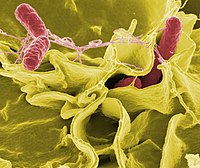
Photo from wikipedia
Dear Editor, Salmonella is one of the major pathogens causing bacterial gastroenteritis or foodborne disease worldwide. Infections with nontyphoidal Salmonella have been reported in more than 2,000 patients in Korea… Click to show full abstract
Dear Editor, Salmonella is one of the major pathogens causing bacterial gastroenteritis or foodborne disease worldwide. Infections with nontyphoidal Salmonella have been reported in more than 2,000 patients in Korea every year from 2017 to 2019, and it is the fifth most common cause of gastrointestinal infections in Korea following norovirus, C. perfringens, Campylobacter, rotavirus group A [1]. Non-typhoidal Salmonella infection usually manifests as acute onset of fever, chills, vomiting, and diarrhea, and focal or blood-stream infections develop in some cases [2]. Production of hydrogen sulfide (H2S) is a unique property of Salmonella, and it is commonly detected to differentiate Salmonella species from other bacterial pathogens using biochemical test media such as triple sugar iron (TSI) agar. However, several non-H2S-producing Salmonella species have been isolated in various countries (mainly China) from poultry meat [3] or clinical samples such as stool or sacral wound (Table 1) [4-10]. Enzymes encoded by the phs, cysJIH, and asr operons are essential for H2S production. Previous studies reported nonsense mutations at different sites on the phs operon in H2S-negative Salmonella strains [8]. Here, we report a non-H2S-producing Salmonella enterica serovar Infantis clinical isolate obtained from the blood sample of a Korean patient, the first such finding in Korea to our knowledge (Table 1). This study was approved by the Institutional Review Board. A 63-year-old woman was admitted to Severance Hospital, Seoul, Korea, from January to February 2019 for flank and pelvic pain, and poor general condition. Eight years ago, she was diagnosed as having pancreatic neuroendocrine carcinoma with multiple liver metastases and diabetes mellitus. The patient received chemotherapies from 2011 to 2018 along with radiation therapy in 2017 for bone metastases. On the second day of hospitalization, fever and chills began, accompanied by watery stool and abdominal pain. Her complete blood counts were as follows: leukocytes, 5.2×10/L (neutrophil 82.9%); hemoglobin, 88 g/L; platelets, 111×10/L. Results of biochemical analysis were as follows: BUN/Cr, 15.7/0.15 nmol/L; C-reactive protein, 1,625.7 nmol/L. Urinalysis with microscopy showed 2+ blood, 2+ ketone,
Journal Title: Annals of Laboratory Medicine
Year Published: 2020
Link to full text (if available)
Share on Social Media: Sign Up to like & get
recommendations!